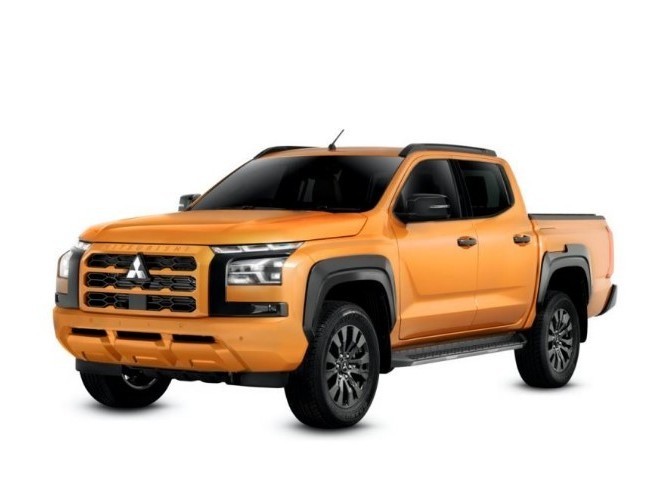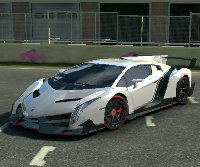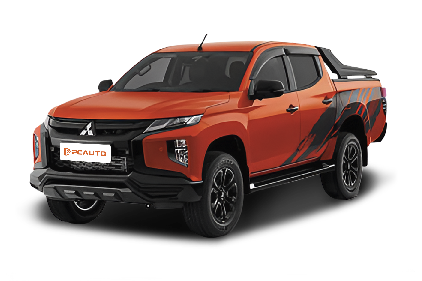Q
How much power does the 2021 Mitsubishi Triton have?
The 2021 Mitsubishi Triton offers varying powertrain configurations across its trim levels in the Malaysian market. The range-topping Triton Athlete is equipped with a 2.4-liter MIVEC turbocharged diesel engine, churning out 181 horsepower and a peak torque of 430 Nm, paired with a 6-speed automatic transmission that balances off-road capability with daily driving needs. Entry-level models, on the other hand, use the same engine but in a slightly detuned state, delivering 150 horsepower and 400 Nm of torque.
This pickup truck is renowned for its robust chassis and Super Select 4WD system (available on certain variants), making it well-suited for Malaysia's diverse terrains. It also boasts a 5,250kg towing capacity, catering to both commercial and recreational demands. Notably, the diesel engine's low-end torque trait excels when hauling heavy loads or climbing slopes, while Mitsubishi's Dynamic Shield design language gives the exterior a modern touch. For users prioritizing fuel efficiency, the Triton's AdBlue diesel exhaust treatment technology effectively reduces emissions, complying with Malaysia's increasingly stringent environmental standards. These features keep it competitive in the local pickup truck market.
Special Disclaimer: This content is published by users and does not represent the views or position of PCauto.
Related Q&A
Q
What is the fuel economy of the 2021 Triton?
The fuel efficiency of the 2021 Mitsubishi Triton in the Malaysian market varies by model and drivetrain. According to official figures, the 2.4-liter turbo diesel engine (4N15 model) delivers a combined fuel consumption of approximately 7.6 liters per 100 km for the 2WD manual variant, while the 4WD automatic version comes in around 8.2 liters per 100 km. This engine features Mitsubishi's innovative variable geometry turbo technology, balancing low-end torque with high fuel efficiency. For Malaysian users who frequently need to carry loads or drive long distances, the diesel engine's low-rev, high-torque characteristics are particularly well-suited for local mountainous terrain and hot climatic conditions. It's worth noting that actual fuel consumption can be affected by driving habits, road conditions, and payload. Owners are advised to perform regular vehicle maintenance and maintain proper tire pressure to achieve optimal fuel efficiency. Among pickups in its class, the Triton's fuel economy ranks above average. Its Super Select 4WD-II system not only provides off-road capability but also optimizes power distribution for on-road driving, which is especially useful during the rainy season on Malaysia's east coast or for plantation road conditions. To further reduce fuel consumption, consider using the factory-fitted ECO driving mode, which enhances efficiency by adjusting throttle response and shift logic.
Q
What are the most common problems with the 2021 Mitsubishi Outlander Sport?
Common issues with the 2021 Mitsubishi Outlander Sport in the Malaysian market include transmission jerkiness, especially noticeable during low-speed gear changes. This is likely due to the CVT transmission tuning prioritizing fuel efficiency, so it's advisable to regularly check the transmission fluid condition to ensure smooth operation. Some owners have reported that the suspension is on the stiff side, which compromises comfort a bit when going over rough roads in Malaysia, but this actually enhances the vehicle's stability in corners. Interior sound insulation is average; wind and tire noise become quite noticeable at highway speeds, and upgrading the insulation materials could help improve this. Additionally, the infotainment system occasionally exhibits slow response; keeping the system software updated usually resolves such issues. It's worth noting that the car's 1.5L MIVEC engine performs reliably in Malaysia's hot climate, with a cooling system design that handles high temperatures well, and maintenance costs are relatively reasonable, making it well-suited for local consumers. Despite these minor drawbacks, the Outlander Sport remains a popular choice in Malaysia's urban SUV segment thanks to its flexible space layout and higher ground clearance compared to its peers. Prospective buyers are advised to pay close attention to the above aspects during a test drive to ensure it meets their personal needs.
Q
How many miles per gallon does a 2021 Mitsubishi get?
Mitsubishi's fuel efficiency in 2021 varies by model and powertrain. Take the Outlander, for example – the 2.4L four-cylinder front-wheel-drive version gets around 25 mpg combined (about 10.6 km/L). The plug-in hybrid (PHEV) model, on the other hand, delivers better efficiency in all-electric mode, though actual numbers depend on driving conditions and battery state. For Malaysian buyers, fuel economy is also affected by local road conditions, driving habits, and fuel quality. It’s best to check Mitsubishi Malaysia’s official localized data or real owner reviews for the most accurate info. With hybrids and EVs gaining traction globally, if you’re thinking about long-term running costs, keep an eye on Mitsubishi’s new energy tech – stuff like the PHEV system’s regenerative braking and all-electric range, which can really cut down on fuel use for city commutes. When picking a model, make sure to factor in your daily driving distance and how easy it is to access charging stations.
Q
What kind of engine is in the 2021 Triton GSR?
The 2021 Mitsubishi Triton GSR is powered by a 2.4-liter MIVEC turbocharged diesel engine, which features Mitsubishi's advanced common-rail direct injection technology and a variable geometry turbocharger. It cranks out 181 horsepower and a peak torque of 430 Nm, mated to a 6-speed automatic transmission, delivering strong performance and impressive fuel efficiency. It's perfectly suited for Malaysia's diverse road conditions, handling both city driving and off-road adventures with ease. This engine also meets Euro 5 emission standards, showcasing Mitsubishi's commitment to eco-friendly technology. For Malaysian consumers, the Triton GSR's engine isn't just powerful; it's also highly durable and relatively low-maintenance, making it a standout in Mitsubishi's pickup truck lineup. What's more, the turbo diesel engine provides high torque at low revs, making the vehicle particularly capable when hauling loads or towing, ideal for users who need frequent transportation or enjoy outdoor activities.
Q
What is the fuel consumption of the Mitsubishi Triton 2021?
The fuel consumption of the 2021 Mitsubishi Triton varies depending on the drive type and transmission configuration. According to official figures, models equipped with the 2.4-liter turbocharged diesel engine (with MIVEC technology) have an average fuel consumption of approximately 7.6 liters per 100 kilometers for the manual transmission version, and around 8.0 liters per 100 kilometers for the automatic transmission version. Four-wheel drive models have slightly higher fuel consumption due to additional mechanical losses, but overall, it remains one of the more fuel-efficient pickups in its class. This engine's ability to deliver high torque at low revs makes it well-suited for Malaysia's hilly terrain and cargo-carrying needs, while its ECO driving mode further optimizes fuel efficiency. It's worth noting that actual fuel consumption can be affected by driving habits, road conditions, and load. It's recommended that owners perform regular maintenance, such as cleaning the air filter and changing the oil promptly, to maintain optimal fuel efficiency. For Malaysian users who frequently drive long distances or need a vehicle that balances family and commercial use, the Triton's balanced fuel economy and reliability make it a solid choice. Other models in the same class with similar performance include the Toyota Hilux and Ford Ranger, though each has slightly different tuning priorities.
Q
How much can a 2021 Mitsubishi Triton tow?
The 2021 Mitsubishi Triton offers a maximum towing capacity of 3.1 tonnes (3100kg) in the Malaysian market. This figure applies to the automatic transmission models equipped with the 2.4-liter turbocharged diesel engine, which cranks out 181 horsepower and 430 Nm of torque—plenty of muscle to handle towing needs. It’s important to note that actual towing performance depends on factors like trailer type, load distribution, and road conditions. Owners should always consult the vehicle manual before hauling heavy loads and ensure the towing setup is properly installed.
Underpinning the Triton is a chassis built with high-strength steel and a reinforced suspension system, both working to boost towing stability. The standard trailer stability control system also helps minimize trailer sway during driving, adding an extra layer of safety. For those who tow regularly, keeping an eye on transmission oil temperature, brake system condition, and tire wear is crucial—these small checks go a long way in extending vehicle life and ensuring safe journeys. Malaysia’s hilly terrain and humid climate can affect towing performance, so it’s wise to reduce speed slightly and take more frequent breaks during long trips or when carrying heavy loads to prevent engine overheating.
Q
How big is the 2021 Triton?
The 2021 Mitsubishi Triton, a popular pickup truck in the Malaysian market, measures 5305mm in length, 1815mm in width, and 1780mm in height, with a wheelbase of 3000mm. This size ensures ample passenger space and excellent cargo capacity, with the truck bed sized at 1520mm long, 1470mm wide, and 475mm high – perfect for daily hauling and outdoor adventures. In Malaysia, it's favored for its durability and off-road performance, handling the country's varied road conditions and climate like a champ. The Triton comes with an advanced 4WD system and multiple driving modes, making light work of tricky terrains. Inside, the focus is on practicality and comfort, featuring a multifunction steering wheel and touchscreen infotainment system to up the driving experience. For Malaysian buyers, the Triton isn't just a workhorse; it's also a solid choice for family getaways. Its reliability and versatility keep it competitive in its class.
Q
What size Tyres are on a 2021 Mitsubishi Triton?
The 2021 Mitsubishi Triton comes with different tire sizes across its variants in the Malaysian market. Mainstream models like the Triton VGT Adventure and Triton VGT AT typically roll on 265/60R18 tires, while entry-level trims such as the Triton Quest might feature smaller 245/70R16 rubber. These sizes are engineered to balance on-road comfort with light off-road grip. Breaking down the specs: 265 is the tread width in millimeters, 60 is the aspect ratio (sidewall height as a percentage of tread width), R stands for radial construction, and 18 is the wheel diameter in inches. Picking the right tire size is crucial for performance—wider treads boost cornering stability, while taller sidewalls (higher aspect ratios) handle rough terrain better. When replacing tires, Malaysian owners should factor in local weather too. The rainy climate calls for tread patterns with good water dispersion, while frequent mud or gravel driving might warrant all-terrain (AT) tires. Also, always ensure new tires meet the manufacturer's load index and speed rating to maintain safety and warranty coverage.
Q
What engine does a 2021 Triton have?
The 2021 Mitsubishi Triton offers a range of engine options in the Malaysian market, including a 2.4-liter MIVEC turbocharged diesel engine and a 2.4-liter naturally aspirated petrol engine. The diesel variants come in two tunes: 4N15 and 4N16. The 4N15 delivers 133kW (181hp) of maximum power and 430Nm of peak torque, while the 4N16 ups the ante to 150kW (204hp) and 470Nm. Both diesel options are mated to either a 6-speed manual or 6-speed automatic transmission. On the petrol side, you're looking at 128hp, which is a solid choice for folks who prioritize fuel economy.
Mitsubishi's diesel engine in the Triton packs advanced common rail injection tech and a variable geometry turbocharger, so it's not just about brute power—it balances that with decent fuel efficiency too. That makes it really well-suited for Malaysia's diverse road conditions, handling everything from daily city commutes to long-distance off-road jaunts without breaking a sweat.
Plus, the Triton comes with the Super Select 4WD-II system, offering multiple driving modes to choose from. This really boosts the vehicle's adaptability and handling. All these features keep the Triton pretty competitive in Malaysia's pickup truck market.
Q
What is the fuel consumption of the 2021 Triton?
The fuel economy of the 2021 Mitsubishi Triton varies depending on engine configuration and drivetrain. Models equipped with the 2.4-liter MIVEC turbodiesel engine achieve an average combined fuel consumption of approximately 8.0 liters per 100 kilometers (around 12.5 kilometers per liter), while the 4WD version may be slightly higher at 8.5 liters per 100 kilometers (about 11.8 kilometers per liter) due to additional driveline losses. Actual fuel consumption can also be affected by driving habits, vehicle load, and road conditions. This pickup truck features Mitsubishi's advanced diesel technology, balancing high low-end torque output with fuel efficiency, making it suitable for Malaysia's varied terrain usage scenarios. It's worth noting that diesel engines are generally more fuel-efficient than gasoline engines for long-distance driving and heavy-load situations, which is one reason the Triton is popular in commercial and off-road applications. We recommend owners perform regular engine maintenance and replace air filters to maintain optimal fuel consumption performance, and using diesel that meets Malaysia's B7 standard can further optimize combustion efficiency. To accurately monitor fuel consumption, you can refer to the on-board computer data or use the manual calculation method of dividing fuel dosage by distance traveled.
Latest Q&A
Q
What are the brake issues on the 2021 Nissan Rogue?
Some owners of the 2021 Nissan Rogue in the Malaysian market have reported brake issues, mainly focusing on a longer brake pedal travel or a soft initial braking force. This situation may be related to the hydraulic adjustment of the brake system or the break-in characteristics of the brake pads, and it becomes more noticeable especially when the brakes are used frequently in Malaysia's rainy weather. However, Nissan has already improved this phenomenon by optimizing the response logic of the brake assist system through software updates. It's worth adding that any new car's brake system requires a break-in period of about 500 kilometers to reach optimal performance. Owners are advised to avoid sudden braking and emergency braking and stopping driving habits, and regularly check the brake fluid moisture content (it's recommended to replace it every 2 years in Malaysia's hot and humid climate) and the brake pad thickness (replace when it's below 3mm). If brake noise or pedal vibration is noticed, it's necessary to go to an authorized service center for inspection immediately, as this may be a normal phenomenon caused by brake disc wear or ABS system intervention. Malaysian owners also need to pay special attention to increasing the following distance when driving in the rainy season, as wet roads can extend the braking distance by about 20%-30%.
Q
How much are brakes for a 2021 Nissan Rogue?
The brake system replacement cost for the 2021 Nissan Rogue (X-Trail) in the Malaysian market varies depending on the specific configuration and service channel. Original equipment brake pad typically range from RM400 to RM800 (per axle, front or rear). If brake discs need to be replaced at the same time, the total cost can reach RM1,500 to RM3,000, depending on whether you choose original parts or high-quality third-party brands like Brembo or AKEBONO. Independent repair shops usually offer prices 20%-30% lower than authorized 4S dealerships, but it's advisable to prioritize Nissan-certified service centers to ensure compatibility. It's worth noting that the regenerative braking system in hybrid Rogue models can affect brake pad wear cycles, extending replacement intervals to every 60,000-80,000 kilometers (compared to around 40,000-50,000 kilometers for the standard version). During daily driving, if you notice brake pedal vibration, unusual noises, or increased braking distance, you should promptly check the brake fluid level and line tightness. In Malaysia's tropical climate, it's recommended to replace DOT4 brake fluid every 2 years. For car owners focused on value for money, Japanese brand DIXCEL or local Malaysian brand MEKAR brake components are viable options, but ensure they meet JASO or SAE standards. Regular cleaning of brake caliper slide pins can also effectively prevent uneven wear caused by dust accumulation.
Q
Are 2021 Nissan Rogue AWD?
The 2021 Nissan Rogue (known as the X-Trail in some markets) does offer an AWD (All-Wheel Drive) variant, equipped with Nissan's Intelligent AWD system. This setup automatically distributes torque between the front and rear wheels based on road conditions, enhancing traction on slippery surfaces or during light off-roading—perfect for Malaysia's rainy climate and suburban road conditions. The AWD system also features drive mode selection, including Standard, Eco, Sport, and Snow modes (though the latter sees less use in Malaysia), balancing fuel efficiency with handling stability. It's worth noting that the 2021 Rogue rides on the new CMF-C platform, which boosts body rigidity while reducing weight. Paired with a 2.5L four-cylinder engine (181 horsepower) and CVT transmission, the overall tuning leans toward comfortable family use. The AWD version does see a slight reduction in trunk space (approximately 1,996 liters with the seats folded down). For Malaysian consumers who frequently tackle muddy roads or mountainous trips, the AWD variant provides extra safety assurance. However, if city driving is your primary use, the front-wheel drive version is sufficient and more fuel-efficient. Competitors in the same segment, like the Toyota RAV4 or Honda CR-V, also offer similar AWD technology, so it's advisable to test drive and compare based on actual needs.
Q
Does the 2021 Nissan Rogue have automatic braking?
Yes, the 2021 Nissan Rogue (known as the X-Trail in Malaysia) comes with Automatic Emergency Braking (AEB) as part of Nissan's Safety Shield 360 package. This system uses a front-facing camera and radar to monitor for vehicles or pedestrians ahead, automatically triggering the brakes if a potential collision is detected to either reduce the risk of impact or minimize injury. Beyond AEB, the 2021 Rogue also offers other advanced driver-assistance features like blind-spot monitoring, lane-keeping assist, and rear cross-traffic alert—all working together to boost on-road safety. In the Malaysian market, these kinds of safety features are gaining more attention from consumers because they effectively lower the risk of rear-end collisions in congested urban areas, especially in busy spots like Kuala Lumpur. It’s important to note, though, that while automatic braking systems can assist drivers, you still need to stay focused behind the wheel. The system might have limitations in certain complex road conditions or bad weather, which is a common trait across all brands' ADAS systems these days.
Q
How do you start a 2021 Nissan Rogue with the key fob?
To remote start your 2021 Nissan Rogue with the key fob, first make sure the vehicle is in Park and all doors are closed. Then, within the key fob's effective range (about 80 meters), quickly press the lock button once, and immediately hold down the engine start button (the one with the arrow icon) for about 2 seconds until the turn signals flash and the engine starts. It's worth noting this feature is super handy in Malaysia's hot weather—you can fire up the AC early to cool things down. But don't use it in enclosed spaces like garages, though; you don't want exhaust fumes building up. The Rogue's smart key system also does keyless entry—just keep the key on you, grab the door handle, and it unlocks. This tech's pretty much become standard on mainstream SUVs in Malaysia these days. Besides the convenience, you can also trigger the car's security alarm in an emergency by holding down the alarm button on the key fob. If the remote start isn't working, it might be a weak key battery or the vehicle detecting a fault code. In that case, check the dashboard for any warning messages or give a Nissan authorized service center a call.
View MoreRelated News

Why is the Mitsubishi Triton So Popular? Key: Sturdy Chassis and Excellent Four-Wheel Drive
WilliamApr 21, 2025

Brand new Mitsubishi Triton releasing on 16th October, limited time offer price RM102k-RM170k
JohnOct 15, 2024

Toyota HiAce and Mitsubishi Outlander upgraded to receive five-star safety rating
WilliamSep 24, 2025

Mitsubishi Cuts Full-Year Profit Forecast by 30%, Challenged by US Tariffs and Intensified Global Competition
Kevin WongAug 28, 2025

Mitsubishi to Launch Electric Vehicle Based on Nissan Leaf in Second Half of 2026
LienMay 8, 2025
View More















Pros
Cons